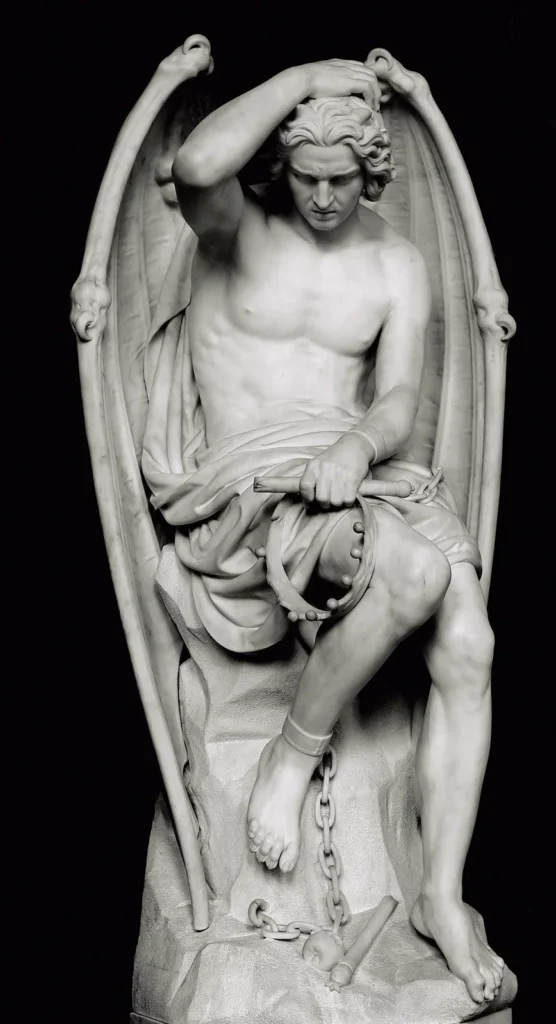
In the realms of mysticism and occult lore, few theories are as provocative as the idea that Samael, Lucifer, and Azrael represent three distinct aspects of a single, multifaceted entity. This concept challenges traditional religious narratives and invites us to explore the blurred lines between light and darkness, creation and destruction. In this article, we’ll delve into the historical backgrounds of these enigmatic figures, examine the symbolic connections that tie them together, and consider the interpretations that fuel this controversial theory.
An Introduction to the Mystical Trinity of Samael/Lucifer/Azrael
Across different cultures and religious traditions, angelic figures often carry deep symbolic meanings. Samael, Lucifer, and Azrael have typically been portrayed as separate beings with unique roles. From the archangel of death to the fallen bearer of light there is a lot of variation. Some esoteric traditions propose that they three facets of a singular cosmic force. This unified entity embodies the duality of existence. Representing both the destructive and transformative powers of life.
Who is Samael?

Samael is a figure steeped in ambiguity and dualism. In Jewish mysticism, he is often associated with:
- Destruction and Justice: Seen as both an accuser and a punisher. Samael’s role encompasses the darker aspects of divine retribution.
- The Angel of Death: Often linked with the process of dying. He is portrayed as the harbinger of the end of life. Yet he is sometimes also the initiator of transformation.
His complex character has made him a subject of intrigue for scholars and occult enthusiasts alike. He straddles the boundaries between benevolence and malevolence.
Understanding Lucifer

Lucifer’s identity has evolved considerably over time. Traditionally recognized as:
- The Light Bringer: His name, meaning “light-bringer” in Latin, reflects his association with enlightenment and the pursuit of knowledge.
- The Fallen Angel: Over centuries, Lucifer’s narrative shifted to symbolize rebellion against divine order—a transformation from grace to defiance.
In many occult traditions, Lucifer is not simply the embodiment of evil but also a symbol of individualism and truth. Representing the struggle to reconcile inner light with external darkness.
Who is Azrael?

Azrael occupies a unique position in various religious texts, particularly within Islamic tradition, where he is often known as:
- The Angel of Death: Responsible for escorting souls from the mortal realm to the afterlife. Azrael is a compassionate figure who administers the natural cycle of life and death.
- A Guide Through Transition: Beyond his association with mortality, Azrael’s role as a guide suggests a transformative journey. One that is both inevitable and necessary for the evolution of the soul.
His gentle stewardship over the process of dying contrasts with the more aggressive imagery often associated with Samael. Yet both figures share the common thread of mediating between life and the unknown.
The Theory: Three Faces of the Same Entity

Bridging Dualities
At the heart of this theory is the idea that these three figures—Samael, Lucifer, and Azrael—are not separate entities. Rather different expressions of the same underlying force. This perspective is rooted in several key themes:
- Duality and Balance: Many mystical traditions emphasize that creation is governed by opposing forces. Light and darkness, creation and destruction, life and death—all coexist in a dynamic equilibrium.
- Transformation and Transition: Each figure plays a role in the process of transformation. Whether it is through the ending of life, the rebellion against established order, or the delivery of enlightenment, all three contribute to a cyclical process of renewal.
- Esoteric Symbolism: In occult teachings, the symbolism attached to each figure is less about their literal historical roles and more about what they represent in the human journey. Samael’s stern justice, Lucifer’s illuminating defiance, and Azrael’s compassionate passage through death are seen as complementary forces that shape human experience.
Interpretative Possibilities
Scholars and practitioners of esoteric traditions have offered several interpretations of this unified theory:
- Spiritual Alchemy: Just as alchemists sought to transform base metals into gold, this theory suggests that the interplay of these three aspects leads to spiritual transformation. The integration of opposing qualities results in a higher state of consciousness.
- The Shadow Self: Psychologically, the idea can be seen as an exploration of the “shadow self” — the hidden or suppressed parts of our nature. Recognizing and integrating these aspects can lead to personal growth and self-realization.
- Cosmic Cycles: On a more metaphysical level, the concept underscores the cyclical nature of existence. Life, death, and rebirth are not linear events but interconnected stages of a continuous process.
Historical and Cultural Context
Ancient Texts and Traditions
The roots of this theory can be traced back to ancient mystical texts. Religious commentaries where figures like Samael, Lucifer, and Azrael appear under various guises. Their portrayals have often shifted over time, influenced by:
- Gnostic Beliefs: Early Gnostic texts frequently reinterpreted traditional religious figures, imbuing them with new symbolic meanings that challenged orthodox views.
- Medieval Mysticism: During the Middle Ages, the blending of Judaic, Christian, and Islamic traditions led to a rich tapestry of interpretations regarding angels, demons, and the forces of life and death.
- Modern Occultism: In contemporary esoteric circles, these figures are often seen as archetypes—universal symbols that transcend specific religious doctrines and speak to the human experience of duality.
Cultural Resonance
The enduring fascination with these figures is evident in literature, art, and even modern media. Whether depicted as tragic antiheroes or as complex spiritual guides, the images of Samael, Lucifer, and Azrael continue to captivate our collective imagination. This resonance speaks to a deeper, almost primal recognition of the forces that shape our inner lives.
The Debate: Controversy and Acceptance
While the theory of a unified entity encompassing Samael, Lucifer, and Azrael is captivating, it remains a subject of debate among scholars and spiritual practitioners. Key points in the debate include:
- Doctrinal Challenges: Mainstream religious institutions tend to maintain clear distinctions between these figures, often rejecting the notion of their unification as contrary to established theological teachings.
- Interpretative Flexibility: Esoteric interpretations are inherently fluid, allowing for a wide range of symbolic readings. This flexibility is both a strength and a source of contention, as it can lead to vastly different conclusions based on the same mythological material.
- Modern Spirituality: In today’s context, many spiritual seekers are drawn to syncretic ideas that blend elements from multiple traditions. For these individuals, the theory offers a way to reconcile the polarities of human existence, embracing both the light and dark aspects of their nature.
Concluding Thoughts
The theory that Samael, Lucifer, and Azrael are three faces of the same entity challenges us to rethink the conventional narratives of good versus evil and life versus death. By examining these figures through the lens of duality, transformation, and cosmic balance, we gain a richer understanding of the forces that govern our inner and outer worlds.
Whether viewed as a metaphor for personal growth, a representation of spiritual alchemy, or a commentary on the cyclical nature of existence, this unified theory encourages a more nuanced exploration of mythology and mysticism. As with many esoteric ideas, its true value may lie not in its literal truth but in its ability to inspire deeper reflection on the mysteries of life and death.

